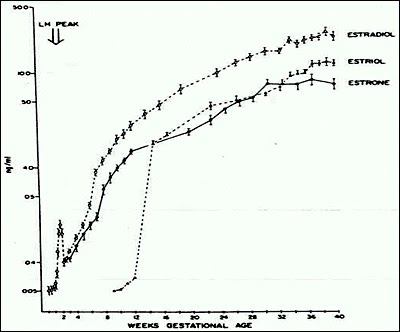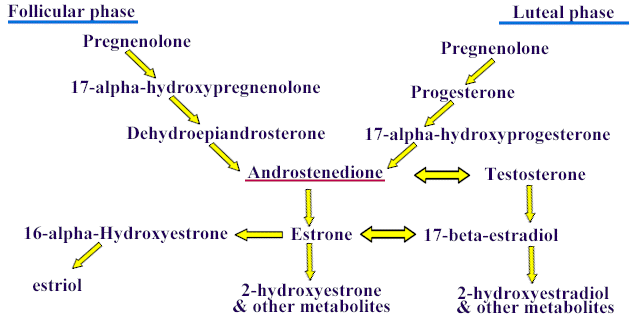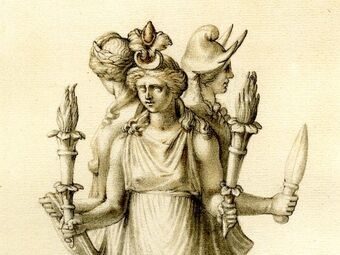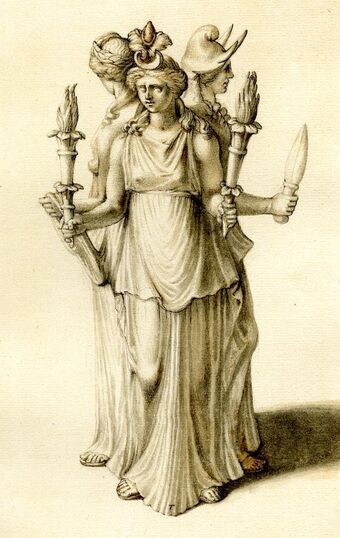One of the cross-cultural archetypes observed by mythographers is the motif of the Triple Goddess. In the Greek pantheon, the Triple Goddess is called Hecate. Hecate is often depicted in art with three faces. The most common interpretation is that the first face of Hecate is the Maiden, the second face is the Mother, and the third face is the Crone. What is the neuromythographic interpretation of this this universal human myth?
Estrogen is the main female sex hormone. However, there are three main types of estrogens: estradiol, estriol, and estrone.
Hecate the Maiden: Estradiol (E2)
Estradiol is secreted by the ovaries, and is responsible for the development of secondary sexual characteristics in young females, including the breasts, the widening of the hips, and the onset of menstruation. It is the most powerful of the three estrogens. Estradiol is Hecate the Maiden.
Estradiol also has a significant effect in males. Applying estradiol to certain brain areas triggers aggression towards other males (but not towards females). Estradiol does not function this way in females.
Hecate the Mother: Estriol (E3)
Estriol is mainly present in women during pregnancy, when it increases by a thousand-fold. It is synthesized by the placenta, spiking up around week 12 of pregnancy. Estriol remodels the brain in preparation for motherhood, reducing emotional stress, reducing the gray matter areas associated with past autobiography, and preparing the brain for bonding with infants. Estriol also elevates maternal aggression towards dangers to her children. Estriol is Hecate the Mother.

Hecate the Crone: Estrone (E1)
Estrone is the predominant estrogen in post-menopausal women. Estrone is the basic estrogen that is converted to either estradiol or estriol. After menopause, this conversion takes place at lower levels. Estrone is Hecate the Crone.
Inanna (ER-A) and Cybele (ER-B): The Estrogen Receptors
The three estrogens described earlier act upon two cell receptors, known as estrogen receptor-alpha (ER-A) and estrogen receptor-beta (ER-B).
ER-A is associated with the lively and dark sides of femininity, and is represented in neuromythography by the archetype Inanna. Inanna is an ancient Mesopotamian goddess associated with love, beauty, sex, war, justice and political power.
ER-B is associated with the calmer, contemplative side of femininity, and is represented by the Anatolian goddess Cybele. Cybele was known as the Mountain Mother, and became known as the Magna Mater (“Great Mother”) when adopted by the ancient Romans.
Together, ER-A and ER-B represent the contradiction to be balanced by all women between these two sides of femininity. The three faces of Hecate (estrone, estradiol, and estriol) bind with both of these receptors, regulating behavior and mood. The expression of ER-A (Inanna) and ER-B (Cybele) changes dynamically across different brain areas, depending upon health, experience, and other conditions.
Going Deeper
A 2020 study found that the measured levels of E2 (Maiden) and E1 (Crone) in a study cohort of women affected the functional connectivity of the brain when recalling verbal memories:
E1 was positively associated with connectivity between the hippocampus and
rostral anterior cingulate cortex (ACC), mid cingulate, dorsal ACC, and left insula
during verbal encoding. E2 was positively associated with connectivity with rostral
ACC/medial PFC and left orbital inferior frontal cortex during encoding and connectivity with rostral ACC, bilateral orbital PFC, bilateral middle temporal cortex, precuneus
and posterior cingulate cortex during retrieval.
The three faces of Hecate (the three estrogens) that are dominant at different times during women’s lives affect how the rest of the brain views memories and choices.
Synthesis

Hecate is often associated with the phases of the moon, which are connected to the monthly menstrual cycle. The above diagram depicts the synthesis pathways for estriol (left), estrone (center), and estradiol (right). We can see that the two phases of the menstrual cycle (follicular and luteal) ultimately lead to a ‘crossroads’ intermediate called androstenedione.
In males, androstenedione is related to Jungian anima. In healthy young males, it is mostly converted to testosterone and related androgens. As men age, more androstenedione goes down the estrogen pathway, which is part of why men and women appear to converge emotionally as they age. Testosterone is also converted to estradiol, which in males triggers aggression towards others. This is the vengeful side of Hecate.
In females, androstenedione is converted to estrone, and from there into estradiol in younger women (or estriol during pregnancy). Aging causes less estrone to be converted into estradiol.

Consider now this classic image of Hecate. Three faces–Maiden, Mother, and Crone representing estrone, estradiol, and estrone. Two torches, representing ER-A and ER-B. A blade, representing the violent aspect of estradiol.
The ancient myths that cross cultures have already pre-explored biology. We just have to understand the meaning of what the ancients already intuited.
